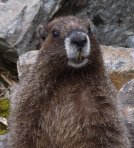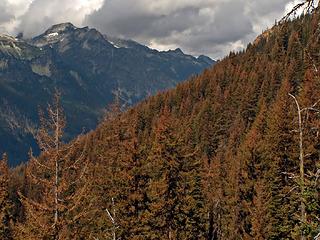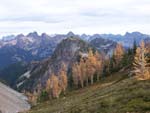| Previous :: Next Topic |
| Author |
Message |
gone
Member


Joined: 08 Feb 2008
Posts: 1051 | TRs | Pics
|
 |
gone
Member
|
 Mon Aug 18, 2008 9:13 pm |
|
|
Beetle attack:
| Quote: | | (Jul 3rd 2008) The mountain pine beetle has infested and killed over half the lodgepole pine forest in the centre of [British Columbia] -- an area larger than England.
...
Scientists now fear the voracious beetle is about to invade the jack pines of the boreal forest, which could see the plague sweep across northern Canada to the Atlantic coast. It is an unprecedented infestation that could become a catastrophe.
...
The infestation is gathering pace: foresters fear that by 2013 four-fifths of British Columbia’s central-southern pine forest will be gone. Wafted eastwards by strong winds, in 2002 the beastie made its debut in northern Alberta and further south in the national parks of Jasper, Banff and Kananaskis on the eastern slopes of the Rocky Mountains. |
I've noticed passing references to this in other threads, the most recent in a wonderful Pea Soup Lake trip report, but I've never seen (and can't find) a thread dedicated to discussing this terrible infestation. Personally, this topic scares the crap out of me and makes me terribly worried for the future of our NW forests.
The scale of the pine beetle's destruction is so large as to be nearly incomprehensible. The article says the red-rust colored BC dead zone can be seen from space. The most unnerving aspect of this, to me anyway, is that there is no known solution capable of dealing an the infestation on this scale. As I understand it, very cold winters (late springs/early falls) and burning (natural and/or preventative) have historically acted as brakes on spread. Noting a sad twist on misplaced eco-friendliness, the article says this about the current outbreak:
| Quote: | | Some forest scientists trace the current outbreak to 1994, when provincial-government foresters, fearing the ire of greens, failed to eradicate a small infestation in a provincial park by cutting and burning. |
Add a couple of decades of warmer winters and it's now a run-away infestation.
I feel like this is one of the most important issues facing our outdoors today, and it crosses multiple disciplines and topics including forest management, environmentalism, global warming, and globalization. If it has already been covered here, I apologize for the repetition. If not, I'd love to hear what you all think about this issue, what you know about what's being done, what you've seen with your own eyes (particularly in the North Cascades).
Additional resources:
Mountain Pine Beetle (Colorado State Univ Extension)
Deaths of trees 'catastrophic'
Mountain Pine Beetle Invasion in Canada Poses Global Warming Threat (pic)
Beetle tree kill releases more carbon than fires (subscription)
Mountain pine beetle and forest carbon feedback to climate change
| Quote: | | In the worst year, the impacts resulting from the beetle outbreak in British Columbia were equivalent to approx75% of the average annual direct forest fire emissions from all of Canada during 1959–1999. The resulting reduction in net primary production was of similar magnitude to increases observed during the 1980s and 1990s as a result of global change5. Climate change has contributed to the unprecedented extent and severity of this outbreak6. Insect outbreaks such as this represent an important mechanism by which climate change may undermine the ability of northern forests to take up and store atmospheric carbon, and such impacts should be accounted for in large-scale modelling analyses. |
|
| Back to top |
  
|
 |
gary
Member


Joined: 07 Sep 2003
Posts: 367 | TRs | Pics
Location: west of Denver |
 |
gary
Member
|
 Mon Aug 18, 2008 9:24 pm |
|
|
When my dad first went to college back in the 50's he started pursuing a forestry degree and they were fighting the beetles back then.
Here in Colorado the problem is mind-boggling. Whole mountainsides browned out with dead trees. Sure makes for dangerous fire conditions.
As I understand it, the beetle is rather selective in what it eats and will eventually die out. It's too late around here. Hopefully due to prevention, eradication, or maybe lack of the right food, WA will fare better...
|
| Back to top |
  
|
 |
peltoms
Member


Joined: 13 Jul 2006
Posts: 1760 | TRs | Pics
Location: Worcester MA |
 |
peltoms
Member
|
 Tue Aug 19, 2008 4:32 am |
|
|
The expansion has been severe of forest decline due to these infestations. From the Spider Meadow trailhead for the first couple of miles the forest is distinctly red, there are also numerous ghost forest already, where the trees are standing but no needles remain. Hiking up to Mount Daniels for the 25th year in a row, , it was last year that the damage began to appear on trees along the trail, this year it was more noticable and the whole Cle Elum drainage between 2500 and 4000 feet is in trouble. This is not a pine forest, this is a spruce and fir dominated forest, and it is the fir that look particularly bad along the Cathedral Rock trail. I look forward to nwhikers providing many more observations on this topic.
|
| Back to top |
  
|
 |
jhiker
Member


Joined: 24 Jul 2006
Posts: 286 | TRs | Pics
Location: Mill Creek |
 |
jhiker
Member
|
 Tue Aug 19, 2008 8:19 am |
|
|
Here is a picture that I took last year on the trail going up to Paddy Go Easy. The effects of the infestation are obvious. The trees were a lot healthier further up but the lower slopes were completely infected as shown here.
 Trees showing effects of Bark Beetle infestation.
|
| Back to top |
  
|
 |
Bryan K
Shameless Peakbagger


Joined: 29 Sep 2005
Posts: 5129 | TRs | Pics
Location: Alaska |
 |
Bryan K
Shameless Peakbagger
|
 Tue Aug 19, 2008 10:06 am |
|
|
I go up to Red Top Lookout a few times a year and the forest around it is greadually getting more brown. Eventually there will be one heck of a wildfire since the beetles are creating so much firewood  But on the bright side, the fires will hopefully kill the little bastages. But on the bright side, the fires will hopefully kill the little bastages.
|
| Back to top |
  
|
 |
peltoms
Member


Joined: 13 Jul 2006
Posts: 1760 | TRs | Pics
Location: Worcester MA |
 |
peltoms
Member
|
 Tue Aug 19, 2008 11:36 am |
|
|
On the way to Paddy go easy are those firs or spruce? It is important to note that there is little pine at elevation such as those.
|
| Back to top |
  
|
 |
Bedivere
Why Do Witches Burn?


Joined: 25 Jul 2008
Posts: 7464 | TRs | Pics
Location: The Hermitage |
 |
Bedivere
Why Do Witches Burn?
|
 Tue Aug 19, 2008 9:13 pm |
|
|
I've been noting the spread of this infestation in WA for a few years now, not sure exactly what it was at first. The USFS really doesn't have much if any info on it on their websites. It appears that our particular infestation is Spruce beetle, which makes sense, but the outcome is the same.
The infestation first really caught my attention when I went car camping along the American River probably 3 or 4 years ago. The entire valley looked dead, especially just on the East side of Chinook Pass.
Since then it seems the infestation has spread rapidly Northward. These pictures were taken along Ingalls creek in August of '06:
Last year in June some friends and I drove up to the Red Top Mountain overlook and all the Spruce and Fir trees as far as you could see from 97 down into the Teanaway were affected.
It appears the Pine Beetle hasn't gotten into the central and Eastern Cascades as the Pines all looked healthy, but I hear they are wreaking havoc up in the Pasayten and areas East of there.
It's also interesting to note that the infestation seems to be confined to a band above approximately 2000-2500 feet and below about 4000-4500 feet. If you go to Waptus Lake you will see this pretty plainly on the hills above the lake.
One ray of hope - many of the trees in the American River valley that looked dead or heavily damaged back in '05 or '06 when I first went there have new growth on them this year. Still lots of dead trees, but also lots that seem to have survived. The valley looks greener than it has in years.
Also, once the needles fall off of all those dead trees the fire danger goes down significantly.
Anyway, I don't have any answers, just a little awe at the power of nature run amok, and a little sadness at the thought of what our forests will look like in 10 years.
|
| Back to top |
  
|
 |
gone
Member


Joined: 08 Feb 2008
Posts: 1051 | TRs | Pics
|
 |
gone
Member
|
 Tue Aug 19, 2008 10:25 pm |
|
|
Thanks, everyone, for contributing experiences, pics, and thoughts.
| Chainsaw_Willie wrote: | | One ray of hope - many of the trees in the American River valley that looked dead or heavily damaged back in '05 or '06 when I first went there have new growth on them this year. Still lots of dead trees, but also lots that seem to have survived. The valley looks greener than it has in years. |
That little sunshine sure helps.  I wonder what kind of recovery there's been in other areas affected over the last few years? I wonder what kind of recovery there's been in other areas affected over the last few years?
| Chainsaw_Willie wrote: | | It's also interesting to note that the infestation seems to be confined to a band above approximately 2000-2500 feet and below about 4000-4500 feet. If you go to Waptus Lake you will see this pretty plainly on the hills above the lake. |
I figured there was probably an elevation band in which the problem was most accute. I suppose this varies as one moves north/south. I wonder how the unseasonably cold/wet winter this year has affected their advance (and/or moved their elevation)?
|
| Back to top |
  
|
 |
yew
non-technical


Joined: 12 Dec 2005
Posts: 1173 | TRs | Pics
Location: Bellingham |
 |
yew
non-technical
|
 Tue Aug 19, 2008 10:27 pm |
|
|
The spruce budworm consumes foliage of fir trees and other conifers especially at middle elevations. I think it a lot of insect effect attributed to pine and spruce beetles in Washington is really spruce budworm.
The USFS and DNR ought to let more fires burn in large roadless areas (especially in the North Cascades) to let a new equilibrium with the new climate become established.
IMO, the forest conditions we see now are more of a result of 60+ years of fire suppression than climate change or enviro group lawsuits.
"I aint jokin woman, I got to ramble...We gonna go walkin through the park every day." - Led Zeppelin
"I aint jokin woman, I got to ramble...We gonna go walkin through the park every day." - Led Zeppelin
|
| Back to top |
  
|
 |
Ski
><((((°>


Joined: 28 May 2005
Posts: 12830 | TRs | Pics
Location: tacoma |
 |
Ski
><((((°>
|
 Tue Aug 19, 2008 10:32 pm |
|
|
| Quote: | | , the forest conditions we see now are more of a result of 60+ years of fire suppression than climate change or enviro group lawsuits. |
well said.
should we wait for the fires? or do some controlled burning? or would the more expedient means of some serious cutting ( as is happening just north of us now ) be more in order, and a preferable ( or acceptable ) alternative to fire?
"I shall wear white flannel trousers, and walk upon the beach.
I have heard the mermaids singing, each to each."
"I shall wear white flannel trousers, and walk upon the beach.
I have heard the mermaids singing, each to each."
|
| Back to top |
  
|
 |
touron
Member


Joined: 15 Sep 2003
Posts: 10293 | TRs | Pics
Location: Plymouth Rock |
 |
touron
Member
|
 Tue Aug 19, 2008 11:51 pm |
|
|
I've always wondered what (unique?) set of conditions allowed for the growth of the huge Douglas Firs seen in some of the old black and white photos.
Touron is a nougat of Arabic origin made with almonds and honey or sugar, without which it would just not be Christmas in Spain.
Touron is a nougat of Arabic origin made with almonds and honey or sugar, without which it would just not be Christmas in Spain.
|
| Back to top |
  
|
 |
Ski
><((((°>


Joined: 28 May 2005
Posts: 12830 | TRs | Pics
Location: tacoma |
 |
Ski
><((((°>
|
 Wed Aug 20, 2008 12:07 am |
|
|
the rain
"I shall wear white flannel trousers, and walk upon the beach.
I have heard the mermaids singing, each to each."
"I shall wear white flannel trousers, and walk upon the beach.
I have heard the mermaids singing, each to each."
|
| Back to top |
  
|
 |
peltoms
Member


Joined: 13 Jul 2006
Posts: 1760 | TRs | Pics
Location: Worcester MA |
 |
peltoms
Member
|
 Wed Aug 20, 2008 3:56 pm |
|
|
yew_betula I agree that much of what we see is Spruce budworm, but I do see alot of fir damage too. As far as it being caused by fire suppression more than climate change. It is a mixture, the blight came on suddenly in several valleys I have visited every year for 25 years immediatley following the three dry warm summers of 2003-2005. Fires would set back the infestations spread, but I have also seen it in some young replanted areas. Any more insights? Treeswarper and other foresters what do you think? I certainly do not see it on the west side.
|
| Back to top |
  
|
 |
SlowWalker
Perma-grinner


Joined: 23 Aug 2005
Posts: 888 | TRs | Pics
Location: Seattle |
The feature article in the July 2008 Washington Trails magazine was about this very topic.
Apparently the Spruce budworm is not a worm, but a moth larvae, and prefers fir to spruce. The article says that while the trees look dead as their needles are eaten, many of them do survive.
The mountain pine beetles, on the other hand, seem to be nasty little buggers who kills trees by boring apartment complexes into the tree, cutting off nutrients to the crown.
I'm just paraphrasing the article and don't know much about it, but I find it fascinating.
|
| Back to top |
  
|
 |
gone
Member


Joined: 08 Feb 2008
Posts: 1051 | TRs | Pics
|
 |
gone
Member
|
 Wed Aug 20, 2008 4:50 pm |
|
|
Great article, thanks for linking it! Lots of good info in there, here are some sunshine highlights:
| Quote: | | “The [Western Spruce Budworm] damage is very ugly but it is not as bad as you think,” says Connie Mehmel, a Forest Service entomologist. “Many trees look dead but they are alive.” ... “What the budworms are doing is eating the new foliage, which eventually turns rusty brown,” she says. “They eat from the top down and the outside in. Most trees do survive and recover, though it may take decades.”
...
[Mountain Pine Beetles] send out a pheromone to attract other beetles and then emit another pheromone basically saying ‘This tree is full up.’...Forest Service is testing spraying pheromones that discourage mountain pine beetles. Such spraying is limited to whitebark pines growing near campgrounds.
...
On the bright side, this most recent spruce budworm epidemic appears to be on the wane. Budworms did affect more trees in 2006 than in 2007. Perhaps the outbreak will last only a couple more years. The effects, however, will be evident for many years to come. Trees will have dead tops and less foliage down lower. “Trees will look wimpy,” says Mehmel.
...
At least most of them aren’t dead, though. |
Of course there's plenty in there to be depressed about, too. As they say, read the whole thing.
|
| Back to top |
  
|
 |
|
|
You cannot post new topics in this forum
You cannot reply to topics in this forum
You cannot edit your posts in this forum
You cannot delete your posts in this forum
You cannot vote in polls in this forum
|
Disclosure: As an Amazon Associate NWHikers.net earns from qualifying purchases when you use our link(s). |